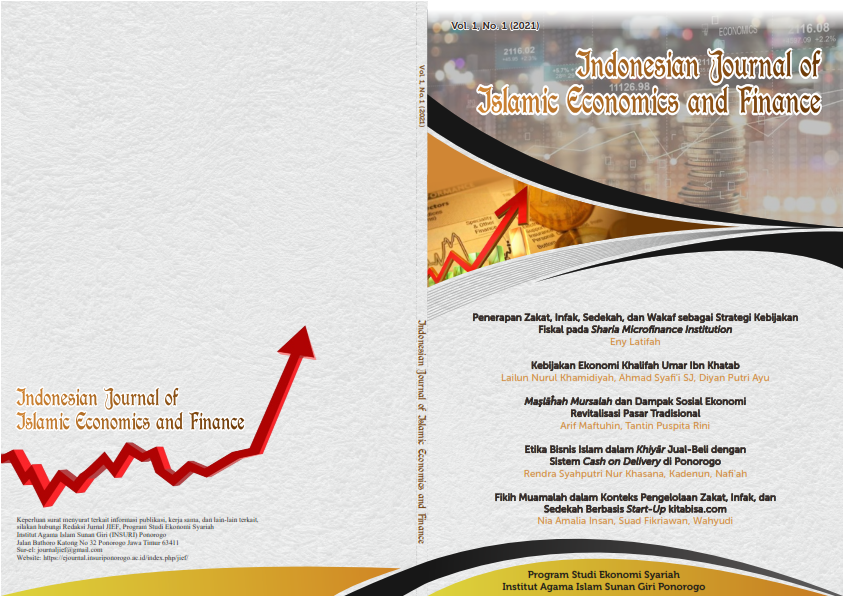The Effect of Inflation, Exchange Rate, and Rubber Production on the Volume of Rubber Exports in the Islamic Economic Perspective in Indonesia
DOI:
https://doi.org/10.37680/ijief.v5i1.7020Keywords:
Inflation, Exchange Rate, Rubber Production, Rubber Export VolumeAbstract
This work aims to analyze the influence of inflation, exchange rate, and rubber production on the volume of Indonesian rubber exports in the perspective of Islamic economics. Indonesia is one of the largest rubber producing countries in the world, with the rubber sector playing an important role in the national economy. Natural rubber commodity not only contributes to the country's revenue through export foreign exchange, but also absorbs large amounts of Labor and supports the downstream industry sector based on rubber raw materials. The work was conducted using panel data from ten major rubber-producing provinces in Indonesia during 2014 to 2023. The analysis method used is panel data regression with common effect, fixed effect, and random effect approaches. The outcomes showed that partially and simultaneously, the three independent elements have a significant influence on the volume of rubber exports. In the Islamic economic perspective, economic stability and Justice of distribution are important cornerstones in understanding the dynamics of export trade. This examination contributes to policy making that is fair and in accordance with Sharia principles in the management of Indonesia's export sector.
References
Aginta, H., & Someya, M. (2022). Regional economic structure and heterogeneous effects of monetary policy: evidence from Indonesian provinces. Journal of Economic Structures, 11(1), 1. https://doi.org/10.1186/s40008-021-00260-6
Agustina, D. S. (2012). Pemanfaatan Kayu Karet Di Beberapa Negara Produsen Karet Alam Dunia. Warta Perkaretan, 31(2), 85. https://doi.org/10.22302/ppk.wp.v31i2.270
Alamsyah, A., Sahuri, S., Nugraha, I. S., & Syarifa, L. F. (2024). Faktor-Faktor Pendukung Yang Mempengaruhi Pertumbuhan Tanaman Karet Di Perkebunan Rakyat: Studi Kasus Di Kabupaten Musi Banyuasin, Sumatera Selatan. Warta Perkaretan, 43(2 SE-Original Research Article), 95–106. https://doi.org/10.22302/ppk.wp.v43i2.1002
Aravik, H., Hamzani, A., & Khasanah, N. (2021). The Role Of The State In The Islamic Economic System: A Review Of Abbas Mirakhor’s Thought. Islamic Banking : Jurnal Pemikiran Dan Pengembangan Perbankan Syariah, 7(1 SE-Articles). https://doi.org/10.36908/isbank.v7i1.271
Arifin, F., Anwar, N., & Gunawan, D. S. (2022). Factors Affecting the Export Value of Indonesian Natural Rubber Commodities. Almana: Jurnal Manajemen Dan Bisnis, 6(3), 460–471.
Ariyanto Anggi, B., Okta, S., & Sy, M. E. (2024). Pengaruh Tingkat Produksi Dan Harga Jual Gula Kelapa Terhadap Pendapatan Produsen Di Desa Karang Anyar Ditinjau Perspektif Ekonomi Islam ( Studi Pada Usaha Produksi Gula Merah Desa Karang Anyar Kecamatan Wonosobo Kabupaten Tanggamus 2022 ). 1425–1443.
Aryanto, S., Syaparuddin, S., & Aminah, S. (2021). Analisis Dampak Nilai Tukar dan Penanaman Modal Asing terhadap Nilai Ekspor Indonesia Periode 1990-2018. Jurnal Ekonomi Aktual, 1(1 SE-), 11–22. https://doi.org/10.53867/jea.v1i1.2
Asrini, A., Devita, A., Rosita, R., & Fitri, R. (2025). Analisis Pengaruh Investasi PMA dan Nilai Tukar terhadap Nilai Ekspor serta Dampaknya terhadap Perekonomian Indonesia. Ekonomis: Journal of Economics and Business, 9(1), 464–469. https://doi.org/http://dx.doi.org/10.33087/ekonomis.v9i1.2069
Azizah, I. A., & Soelistyo, A. (2022). Analisis Faktor-faktor yang Mempengaruhi Nilai Ekspor Batubara Indonesia Tahun 2014-2020. Jurnal Ilmu Ekonomi JIE, 6(4), 584–596.
Bantis, E., Clements, M. P., & Urquhart, A. (2023). Forecasting GDP growth rates in the United States and Brazil using Google Trends. International Journal of Forecasting, 39(4), 1909–1924. https://doi.org/https://doi.org/10.1016/j.ijforecast.2022.10.003
Beckmann, J., Czudaj, R. L., & Arora, V. (2020). The relationship between oil prices and exchange rates: Revisiting theory and evidence. Energy Economics, 88, 104772. https://doi.org/https://doi.org/10.1016/j.eneco.2020.104772
Buckley, P. J., Christopher L., P., & and Prescott, K. (1988). Measures of international competitiveness: A critical survey∗ † . Journal of Marketing Management, 4(2), 175–200. https://doi.org/10.1080/0267257X.1988.9964068
Chandra Okspendri, Y. D. (2024). Pengaruh Perdagangan Internasional , Perdagangan Jasa , Dan Inflasi Terhadap Perumbuhan Ekonomi Di Kawasan Negara ASEAN Periode 2018-2022 Dalam Perspektif Ekonomi Islam. 2(4).
Fatahillah, F., Andriyani, D., Rahmah, M., & Syafira, S. (2022). Effect of Rubber Production, Dollar Exchange Rate and Inflation on Rubber Exports In Indonesia. Journal of Malikussaleh Public Economics, 5(1), 1–8. https://doi.org/https://doi.org/10.29103/jmpe.v5i1.8134
Fau, J. F. (2020). Analisis Ekspor Karet dan Kopi Indonesia ke Negara Jepang dan Negara Singapura (Pendekatan Model Gravity). Jurnal Education and Development, 8(3), 932. https://doi.org/https://journal.ipts.ac.id/index.php/ED/article/view/2076
Fihri, F., Haryadi, H., & Nurhayani, N. (2021). Pengaruh kurs, inflasi, PDB dan harga karet internasional terhadap ekspor karet Indonesia Ke Tiongkok dan Amerika Serikat. E-Journal Perdagangan Industri Dan Moneter, 9(3), 141–154. https://doi.org/10.22437/pim.v9i3.16272
Fuadah, N., & Setyowati, E. (2024). Analisis Pengaruh Inflasi, Pertumbuhan Ekonomi, dan Kurs terhadap Volume Ekspor Batubara Indonesia Tahun 1992-2022. JIIP - Jurnal Ilmiah Ilmu Pendidikan, 7(2 SE-), 1166–1173. https://doi.org/10.54371/jiip.v7i2.3830
Izzah, N., Ardilla, C., & Bujana, P. (2025). Pengaruh Produksi Karet , Nilai Tukar , dan Inflasi terhadap Volume Ekspor Karet Indonesia Tahun 2019 s . d . 2023 ( The Influence of Rubber Production , Exchange Rate , and Inflation on Indonesia ’ s Rubber Export Volume from 2019 to 2023 ). 7(2), 295–305. https://doi.org/10.31334/transparansi/
JULIANTI, H. (2022). Analisis Pengaruh Jumlah Produksi Dan Harga Karet Terhadap Ekspor Indonesia Tahun 2014-2018 Dalam Perspektif Ekonomi Islam. Uin Raden Intan Lampung. https://repository.radenintan.ac.id/id/eprint/17951
M. Irfan Rizqi, Cintia Febriliana Putri, Mala Millatina, M. Taufiq Abadi, & Marfita Hikmatul Aini. (2024). Analisis Perekonomian Empat Sektor : Dampak Ekspor Dan Impor Terhadap Pertumbuhan Ekonomi. Jurnal Ekonomi Bisnis Dan Manajemen, 2(1 SE-Articles), 153–163. https://doi.org/10.59024/jise.v2i1.557
Mispa Herlina Wati, Juliana Nasution, & Nur Ahmadi Bi Ahmani. (2023). Pengaruh Produksi Karet dan Harga Karet Alam Internasional Terhadap Nilai Ekspor Karet Alam Indonesia Tahun 2016-2021 dalam Perspektif Ekonomi Islam. Syarikat: Jurnal Rumpun Ekonomi Syariah, 6(1), 181–192. https://doi.org/10.25299/syarikat.2023.vol6(1).13938
Nasuka, M. (2020). Konsep Marketing Mix Dalam Perspektif Islam: Suatu Pendekatan Maksimalisasi Nilai. BISEI : Jurnal Bisnis Dan Ekonomi Islam, 5(01 SE-), 27–46. https://doi.org/10.33752/bisei.v5i01.717
Ngatemini, N., Emilia, E., & Mustika, C. (2022). Pengaruh Produksi, Harga Karet Internasional dan Nilai Tukar terhadap Volume Ekspor Karet Alam Indonesia. Jurnal Ekonomi Aktual, 2(1), 13–22. https://doi.org/10.53867/jea.v2i1.60
Ngatikoh, S., & Faqih, A. (2020). Kebijakan Ekspor Impor: Strategi Meningkatkan Pertumbuhan Ekonomi di Indonesia. LABATILA : Jurnal Ilmu Ekonomi Islam, 4(02 SE-Articles). https://doi.org/10.33507/labatila.v4i02.269
Noviyana, Yulistia Devi, G. U. (2024). Analisis Determinan Cadangan Devisa Di 5 Negara Asean Terpilih Dalam Perspektif Ekonomi Islam Pada Tahun 2015-2023. 2(11).
Nurmalita, V., & Bowo, P. A. (2019). Analisis Faktor-Faktor yang Mempengaruhi Ekspor Minyak Kelapa Sawit Indonesia ke India. Economic Education Analysis Journal, 8(2), 605–619. https://doi.org/https://journal.unnes.ac.id/sju/eeaj/article/view/31492
Perizade, B., & Mulyana, A. (2014). Strategi Percepatan Pengembangan Industri Hilir Karet dan Kelapa Sawit di Sumatera Selatan. Jurnal Manajemen Dan Bisnis Sriwijaya, 12(2), 91–98.
Qi, D., Yang, C., Yun, T., & Wu, Z. (2023). The main service functions and driving forces of rubber (Hevea brasiliensis) plantation ecosystem in China. Journal of Rubber Research, 26(2), 155–164. https://doi.org/10.1007/s42464-023-00202-w
Ramadani, M., Hodijah, S., & Artis, D. (2021). Analisis Ekspor Pulp dan Kertas Jambi ke China. E-Journal Perdagangan Industri Dan Moneter, 9(2 SE-Articles), 59–70. https://doi.org/10.22437/pim.v9i2.6367
Rismiyati, A., Nurjanah, R., & Mustika, C. (2021). Faktor-Faktor yang Mempengaruhi Ekspor Jahe Indonesia. Jurnal Ekonomi Aktual, 1(2 SE-), 99–108. https://doi.org/10.53867/jea.v1i2.22
Samphantharak, K. (2019). Sectoral development in Southeast Asia: agriculture, non-renewable natural resources, manufacture, and services. Non-Renewable Natural Resources, Manufacture, and Services (February 5, 2019). https://doi.org/https://dx.doi.org/10.2139/ssrn.3329048
Scrimger, P. (2017). Comparing Political Units Over Time: An Overview of Time-Series-Cross-Section Analysis. Available at SSRN 2988020.
Silaban, R., & Nurlina. (2022). Pengaruh Nilai Tukar dan Inflasi terhadap Ekspor Non Migas di Indonesia. Jurnal Samudra Ekonomika, 6(1 SE-Articles). https://doi.org/10.33059/jse.v6i1.5123
Suwarno, I., Wianto Putra, I. M., & Sutapa, I. N. (2021). Pengaruh Inflasi, Nilai Tukar Rupiah (USD), Suku Bunga Dan Ekspor Terhadap Cadangan Devisa Negara Indonesia Tahun 2009-2019. Jurnal Riset Akuntansi Warmadewa, 2(1), 48–53. https://doi.org/10.22225/jraw.2.1.2933.48-53
Tistama, R. (2024). Apakah Industri Karet Alam Di Indonesia Dapat Berkelanjutan?: Sebuah Ulasan. Warta Perkaretan, 43(1 SE-Review Article), 39–56. https://doi.org/10.22302/ppk.wp.v43i1.962
Venkatachalam, P., Geetha, N., Sangeetha, P., & Thulaseedharan, A. (2013). Natural rubber producing plants: An overview. African Journal of Biotechnology, 12(12). https://www.ajol.info/index.php/ajb/article/view/128414
Weerathamrongsak, P., & Wongsurawat, W. (2013). The rubber industry of Thailand: a review of past achievements and future prospects. Journal of Agribusiness in Developing and Emerging Economies, 3(1), 49–63. https://doi.org/10.1108/20440831311321665
Wildayanti;, W., Nurjanah, R., & Mustika, C. (2018). Analisis determinan ekspor kayu lapis Indonesia ke Jepang . E-Journal Perdagangan Industri Dan Moneter, 6(3 SE-Articles), 167–176. https://doi.org/10.22437/pim.v6i3.13705
Yaka, Z. (2022). The effects of measures taken in the scope of the Islamic price policy on investment, production, employment, and stability. Ilahiyat Studies, 13(1), 83–117. https://doi.org/https://doi.org/10.12730/13091719.2022.131.234
Zakariya, M. L., Musadieq, M. Al, & Sulasmiyati, S. (2016). Pengaruh Produksi , Harga , dan Nilai Tukar terhadap Volume Ekspor ( Studi pada Volume Ekspor Biji Kakao Indonesia Periode Januari 2010-Desember 2015 ). Jurnal Administrasi Bisnis, 40(2), 139–145.
Downloads
Published
How to Cite
Issue
Section
License
Copyright (c) 2025 Dwi Wijayanti, Budimansyah Budimansyah, Yulistia Devi

This work is licensed under a Creative Commons Attribution-NonCommercial 4.0 International License.
Copyright:
An author who publishes in Indonesian Journal of Islamic Ekonomics and Finance agrees to the following terms:
- Author retains the copyright and grants the journal the right of first publication of the work simultaneously licensed under a Creative Commons Attribution-NonCommercial 4.0 International License that allows others to share the work with an acknowledgment of the work's authorship and initial publication in this journal.
- Author is able to enter into separate, additional contractual arrangements for the non-exclusive distribution of the journal's published version of the work (e.g., post it to an institutional repository or publish it in a book) with the acknowledgment of its initial publication in this journal.
- Author is permitted and encouraged to post his/her work online (e.g., in institutional repositories or on their website) prior to and during the submission process, as it can lead to productive exchanges, as well as earlier and greater citation of the published work (See The Effect of Open Access).
License:
-
Attribution — You must give appropriate credit, provide a link to the license, and indicate if changes were made. You may do so in any reasonable manner, but not in any way that suggests the licensor endorses you or your use.
-
NonCommercial — You may not use the material for commercial purposes.
-
No additional restrictions — You may not apply legal terms or technological measures that legally restrict others from doing anything the license permits.
You are free to:
- Share — copy and redistribute the material in any medium or format
- Adapt — remix, transform, and build upon the material

This work is licensed under a Creative Commons Attribution-NonCommercial 4.0 International License.



.png)







